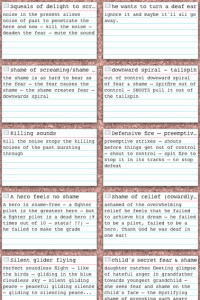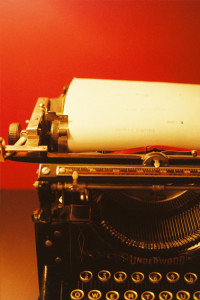'The writing process' - this is a term you might hear often, but how do you put in place a set of writing approaches that will help you finish your novel? Every writer has a process that works for them, and discovering the time, place, tools and other aspects of writing that work best for you will maximize your productivity. Here are 7 steps to creating a writing process that is unique to your own needs:
Work out how much planning you need to stay on track
Do you like to plan ahead with extensive outlines, character charts and chapter synopses, or do you like to just sit down and start writing and see where the story takes you? You might be somewhere in the middle — most writers are — and it may take some trial and error to figure out how much planning is optimal for you. You may surprise yourself by finding that you are more of a planner or pantser than you thought.
The good news is that you don’t have to write a whole novel in order to answer this question.
Note how you feel when you sit down to write without a plan. Are you energized and excited, or do you feel panicked and lost? If it’s the latter, you might be a planner. Alternately, you might try to write an outline. Are the ideas and connections coming to you, or does the story feel lifeless? If it’s the former, you might be a pantser.
There is no right or wrong approach, or rather, whatever writing process works for you is the right one.
You may also find that about one-fourth to one-halfway through the book, your work stalls. If you were writing without a plan, it may be that you really are a planner. If you are writing with a plan, and you get stuck anyway, keep in mind that the outline is not ironclad. You can stop and rework it or deviate from it without completely reworking it.
Figuring out the planning part of your process may take trial and error, and it might even vary from book to book. As important as it is to identify an ideal process for yourself, don’t get too locked into a single way of approaching your novel.
Store your ideas systematically

Whether you are a planner or a pantser, there will be times you will need to organise and archive your thoughts outside of the novel, and there are many different ways you can approach this. As with all aspects of the writing process, you’ll need to experiment to find out which of these work best for you.
One thing you will need to consider is whether you prefer low-tech or high-tech tools and which might make you more productive in your writing life. Do you manage your entire life digitally? If so, you might love an app like Trello. Trello allows you to set up notes much like index cards on a bulletin board or for scheduling. However, Trello can also be customised with templates including templates for film or fiction writing that allow you to plan aspects such as location and characters.
On the other hand, perhaps this seems like an unnecessary complication, and you prefer your index cards and files for organisation. Some writers find they need the tactile nature of these types of tools and that a digital version cannot adequately substitute. There may be something about the kinetic nature of being able to place index cards on a floor or board and switch them around that shakes loose some ideas, so if working with index cards digitally has not worked for you, that does not mean that the same will be true with physical index cards.
You may also want to consider how you best generate and put together ideas. Freewriting might work best for you. On the other hand, you might find that a more visual activity like mind mapping is more helpful. In mind mapping, you begin with an idea in the middle of a page and brainstorm connections off that idea.
The Now Novel Story Builder provides an easy, structured process to help you organise your ideas. Divided into sections for finding, finessing and writing your story skeleton, the tool helps you create a framework step-by-step that simplifies the writing process.
Copy the habits of famous writers
You might also find inspiration in the writing processes of famous writers. Some of those habits are eccentric and may well be apocryphal such as those of Victor Hugo, whose valet was supposedly ordered to refuse him any clothes until he had done his writing for the day! However, plenty of writers also have more conventional habits that you might find useful and inspirational.
One thing many writers share is consistency. They get up at the same time each day and are at their desk at the same time working for a set amount of time or for a certain number of words or pages. Haruki Murakami describes a process by which he 'mesmerises' himself over the course of writing a novel with the repetition of getting up at 4:00 a.m. daily to write for several hours followed by exercise and an early bedtime. Simone de Beauvoir wrote daily from 10 to 1 and 5 to 9. Writing such long hours isn't possible for everyone - many writers have demanding day jobs and have to write in their personal time. This makes being organised all the more necessary.
Other aspects of famous writers' processes might be useful to try. Susan Sontag wrote with a felt-tip pen on legal pads. Joan Didion preferred to sleep in the same room with her manuscript as it neared completion. Ask yourself whether you need a dedicated place to write or whether, like Ray Bradbury and E.B. White, you can write anywhere.
Find your environment: Do you need dedicated writing space?
A writer’s work space is ideally a peaceful room away from any distraction. However, writers often have to work in a variety of circumstances. Some do have offices. Others write in a corner of a room. Still others don’t have a dedicated writing space at all. Some writers cannot abide quiet and solitude and work better in the environment of a coffee shop or library where a certain amount of ambient noise and the presence of others hard at work keeps them focused. Some writers must have music. Others are incapable of writing with music. The best advice is to try writing in different spaces. Where do the best ideas come to you? Are some places better suited to working on certain aspects (such as dialogue) while others are more helpful for planning?
The point here is that you will need to figure out which type of environment works best for you, and you might be surprised, especially if you have always thought writers can only create in hallowed spaces.
Find and schedule the best time for your productivity
You need to try to identify your best time for optimal creativity. However, you may also have to compromise and balance that optimal time with your other commitments. The other element of this is that you need to set and track progress goals. Whether you want to count words or pages, setting goals and tracking your progress will help you stay accountable and motivated. Get a sense of how long on average it takes you to write a page or a certain number of words so that you can estimate how long it will take you to finish the first draft of your novel.
Use a spreadsheet or another simple method of tracking your time and goals. There are a number of apps that can also help you with your time management and organisation. For example, countdown timers such Focus Booster can help you work intensely for short blocks of time.
Decide what writing materials work best for you

How do you prefer to write? Do you like to use a laptop, a tablet, a desktop or pen and paper? If pen and paper is your choice, what type do you prefer? You might like lined spiral notebooks or unlined journals with acid-free paper. Ballpoint pens might do the job for you, or you might prefer fountain pens. Maybe you even like working on an old-fashioned vintage typewriter.
Beyond that, there are many programs and apps that can assist you. Perhaps you’d like to use unusual fonts or different coloured backgrounds for your pages. Although you will eventually need to produce a version of your book in standard manuscript format in order to submit it, you should feel free to be as self-indulgent as you like initially with the visual and tactile element of your writing setup, if it helps your writing process in any way.
Journal your writing process
You might find that your understanding of your own writing process is helped along by journaling your writing process itself. You can keep a private journal in which you write about your various experiments and writing sessions and muse about how things went and what did or didn’t work, or you can do the same thing on a blog or another public forum. If exploring your writing process raises any personal issues you do not wish to write about, you might prefer to keep your journal private.
Discovering your writing process is an essential aspect of completing a novel. In some cases, you may need to experiment and change up your process from book to book. Sometimes, writers find they have mastered one challenge only to find that a new set of challenges requires a new combination of approaches.
The above steps should help you form a structured, conscious writing process. In addition to determining how much planning is necessary for any given novel, you should also work on organising your thoughts and plans for the book. You might draw inspiration from looking at the habits of some of your favourite writers. Other elements you should consider are where and when you work best and what types of writing instruments you work best with. You may find that writing about your process helps you to stay on track and finish your novel.
Need a little extra motivation and guidance to finish your novel? Go here to start using the Now Novel Story Builder.










Great article. I am also a self published author and this is very helpful for those who are looking to start their novel.
Dee Willis - Over 10 years ago
Thanks, Dee! Feel free to share any self-publishing tips you've gained through your own experience, I'd love to know more.
Bridget At Now Novel - Over 10 years ago